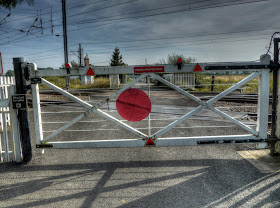There were two reasons for starting this theme. The first was my surprise at how inefficient cars are for mass urban transport. I assumed that other forms of transport would be better – it just surprises me how bad cars are. As mentioned in Part 1, trains are 11x better than cars and cycling is 7x better at urban throughput on a 3m lane. Of course one of the reasons that people like cars is that they provide a point to point service (or at least the illusion of one). W
So the bottom line is that if you are creating an urban environment then you either waste significant space on roads and create a cramped area, constrained by those roads or plan a proper hierarchical transport network. The trouble is cars don’t just take up space when moving they take up space when stationary. This means that if you live in an urban area you either have to pay for parking space (as part of the land your house sits on) or in a communal parking area. Or leave it one the street or pavement. Let’s face it we have all sorts of planning laws about how what can be built and where – cars clogging up pavements is hardly enhancing the urban landscape, it doesn’t do much for the kids who live in the street either.
The realities of car ownership in parts of Cambridge – an urban blight?
But all that aside, I am not nor ever have been a Trainspotter, but I do have a soft spot for trains. I am just about old enough to remember Steam Trains still operating under British Rail. I was too young to understand the impact of the Beeching Cuts though and it is only during the last few years of cycling around exploring the countryside that I have come to realise just how many more railway lines there used to be around the country and how many of the disused routes have been squandered.
At first I came to appreciate the relatively small number of disused routes that have been converted into (shared) cycle routes. The most famous being the Bath-Bristol Cycle path. Which is now a victim of its own success, demonstrating that there isn’t enough like this set aside.
Bath – Bristol Cycle Path
Another example is the Water Rail Way from Lincoln to Boston.
Water Rail Way Bridge at Horsley Deeps
There are more, but I have also come across other old lines that are gradually fading away. Such as the Cambridge to Mildenhall line.
Old Cambridge to Mildenhall Railway Line – near Anglesey Abbey
As I learn more about the Flatlands and venture further afield it amazes me how many railway lines there were in the area. I rather like comparing the older maps of the area with the current situation. Look how many railway lines there were feeding into St Ives. You could catch the train to Huntingdon or Cambridge or Ely or Ramsey.
All that remains is the Cambridge Guided Busway (and cycleway). I can’t claim to understand the relative benefits of the Busway versus a Railway (or a road for that matter). I don’t know what the maximum capacity of the busway is. Apparently the CGB reached more than 6 million journeys by October 2013.
I can’t help but feel that a Guided Busway is probably easier to run because there is less political and union control. According to the throughput chart a bus is rated at 9,000 people per hour in a 3m wide urban, versus a train at 22,000. Well I would assume that the CGB probably falls somewhere between the two?
There might be longer-term trouble ahead apparently with defects and in my view the missed opportunity was not to create a concrete track right into St Ives and beyond to Huntingdon, as well as through Cambridge. The CGB would become an even more attractive transport option if it didn’t get held up in the urban areas it serves.
Cambridgeshire Guided Busway
Which brings me on to a really interesting website – Ouse Washes: Heart of the Fens. I came across (because they borrowed one of my pictures, of a railway bridge – on the Ely Peterborough line across the washes.
Ely-Peterborough Railway Line – Bridge over the Washes
There is a wealth of interesting stuff (well to me) including this on Floods. There are also articles on how the drainage systems in the Fens work to protect us - How it all Works and another feature of how our drainage system than helps keep Essex wet.
What I did enjoy reading about was “Hidden Heritage: the disused Ely and St Ives Railway”. It would seem that the line suffered from a lack of passengers and that freight was the mainstay of its business. Now I knew that there once was a railway there. I used to live in Willingham not far from Earith. However what I didn’t know was that there was an Airfield at Mepal equipped with Thor Intermediate Range Ballistic Missiles.
Even more surprising, well I thought so, was that there was a Hovertrain project at Earith. Now I remember Professor Eric Laithwaite appearing on Tomorrow’s World and talking about the Liner Induction Motor. I shall have to go out exploring in the area in the Summer.
And finally some pictures, of mine along a railway theme
An entrance to Oxford Road Railway Station, Manchester
Trivandrum Railway Station – India
Train Pulling up at Aguas Calientes, Peru
Glenffinnnan Viaduct, Scotland
Woodcroft Level Crossing – ring to cross
I waited 30 minutes for a gap in the trains
Barrington – do they still have steam trains?
Paddington Station – Cycle-friendlier






This comment has been removed by a blog administrator.
ReplyDeleteThis comment has been removed by a blog administrator.
ReplyDelete